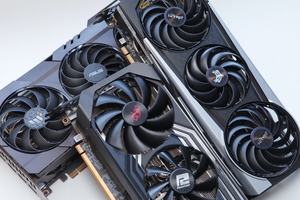Graphics card prices 2021: return to the MSRP market unlikely
Source: Hardware Luxx added 15th Dec 2020Hardly any other topic currently occupies the DIY PC hobbyist as much as the availability of graphics cards. No matter whether NVIDIA’s new GeForce RTX – 30 – or AMD’s Radeon-RX – 6000 – series: Not only are The cards are difficult to get because there are too few quantities, and the prices are far above what the manufacturers of the GPUs (i.e. AMD and NVIDIA) call for the entry-level models, or above the recommended retail prices for the custom- Specify models.
However, you have to differentiate between what manufacturers do with their own online shops and what the offer on the overall market looks like. Yes, AMD and NVIDIA sell the reference versions or the Founders Editions at their own recommended retail prices. Currently, however, none of the GeForce RTX 30 cards in the Founders Edition is available from NVIDIA and this is no longer an RRP card. The same applies to the Radeon-RX – 6000 – series from AMD and the direct offer via AMD.com.
Manufacturers such as ASUS and EVGA have their own Web shops and there the cards are of course offered at their own RRPs, but are also currently not available. Although the manufacturers point out that small numbers of items are always available in the web shop, there can be no question of the willing buyer simply being able to purchase the card – the timing must be right in this case.
What is offered via the price search machines in the “free trade” then usually amounts to a few models that are offered far above the manufacturer’s recommended prices. Supply and demand determine the price and with the gigantic demand this ensures that 150 to 300 euros Surcharges depending on the model are now common – regardless of whether with the GeForce RTX – 30 – or Radeon-RX – 6000 Series.
Partners consider EIAs to be unrealistic
In the past few days and weeks we have worked with numerous partners from AMD and NVIDIA and came across the same assessments over and over again. According to the partners, AMD is said to have come under pressure from NVIDIA’s price targets. You had to keep up with this and not only place your products on an equal footing in terms of performance, but also price them in such a way that they can be an alternative. We now know that the performance (and mostly also the price / performance ratio) is right, but NVIDIA’s aggressive price specifications have evidently pushed all manufacturers (their own partners and AMD together with its partners) into a corner.
The EIAs or entry-level specifications for the smallest models are too tight. In most cases, a manufacturer or the entire value chain, starting with the manufacture of the individual components through to the sale of the entire card in stores, can no longer earn much from the card.
AMD and NVIDIA demand Fixed prices for the packages consisting of GPU and memory and the manufacturer also has little leeway with his customers. The shops are currently the big winners, because they can write almost any price on the cards – the middleman, if any, will certainly also get his piece of the pie.
Improvement is not in sight
In the first quarter 2021 a certain part of the demand should be covered – the manufacturers promise. Then the price structure should normalize again halfway. But there is great doubt that the majority of the cards will then be available at the original MSRP. 2021 the prices of almost all components and assemblies involved should rise. This starts with the manufacture of the GPUs, the memory, the PCB and many other components. The production lines will also 2021 be well utilized, so that the corresponding capacities will cost more.
All of this will hardly be included in an overall price package be able to lace which corresponds to the current specifications. Some manufacturers therefore assume that prices will remain roughly as high as they are currently, or that they will not decline quite as far as one would expect.
There but even the assessment of the current high demand was apparently difficult to assess, this also applies to the graphics card market 2021. At the moment it doesn’t look like normalization.
